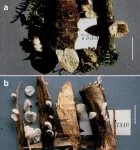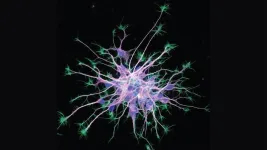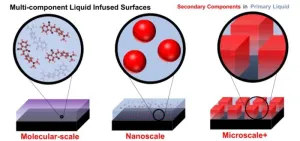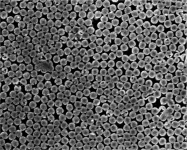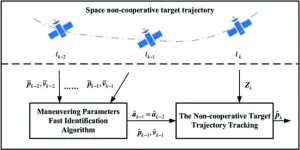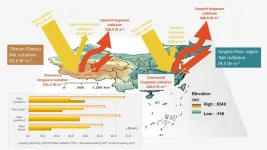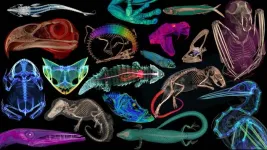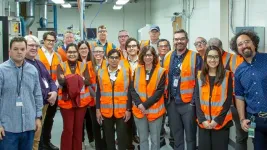(Press-News.org) Washington, D.C. – March 6, 2024 – A new study provides insights into the role of microbes and their interaction as drivers of interspecific differences in coral thermal bleaching. The study was published this week in Applied and Environmental Microbiology, a journal of the American Society for Microbiology.
“The diversity, community dynamic and interaction of coral associated microorganisms play important roles in the health state and climate change response pattern of coral reefs,” said lead study author Biao Chen, Ph.D., an assistant professor with the Coral Reef Research Center of China, School of Marine Science at Guangxi University. “We urge the creation of more expansive coral reef microbial datasets on a global scale and recommend undertaking interdisciplinary research encompassing ecology, marine chemistry, physical oceanography and microbiomics.” The researchers say that creation of the datasets is intended to unveil the crucial role of microorganisms in the adaptability of coral reef ecosystems amid the challenges posed by global warming.
The impacts of global warming have resulted in significant biodiversity losses and coral thermal bleaching in coral reef ecosystems. Coral reefs, also called coral holobionts, are composed of animal hosts, endosymbiotic Symbiodiniaceae (family of marine dinoflagellate), bacteria, archaea, fungi and viruses. Corals have shown significant interspecific differences in bleaching severity and heat tolerance during heatwave events. While researchers know that the coral-associated microbiome plays a crucial role in regulating the environmental tolerance of coral reefs, the interactions between Symbiodiniaceae and fungi on differences in coral heat tolerance are unclear.
To fill this knowledge gap, Chen set out to study Huangyan Island, a reef in the South China Sea with a heightened risk of coral bleaching. This selection was deliberate, due to the notably higher sea surface temperatures of the coral reefs surrounding Huangyan Island compared to the Xisha Islands at the same latitude.
The researchers targeted 18 coral species extensively distributed in the tropical regions of the South China Sea. Their investigation focused on assessing bleaching proportions during the significant coral bleaching event that occurred there in 2020. This examination led to the establishment of a ranking system for the heat bleaching susceptibility of these 18 coral species.
In the final stage of research, the investigators delved into the dynamic interactions within coral organisms, specifically examining the communities of Symbiodiniaceae and fungi. They identified potential correlations between ecological indicators of Symbiodiniaceae and fungi communities and the susceptibility ranking of coral heat bleaching.
The study found that the heat-tolerant Symbiodiniaceae dominated in the microbial community of corals in Huangyan Island. The increase in fungal diversity and pathogen abundance has close associations with higher coral thermal bleaching susceptibility. The researchers constructed an interaction network between Symbiodiniaceae and fungi in corals, which indicated that restricting fungal parasitism and strong interaction network resilience would promote heat acclimatization of corals.
“Our study highlights the ecological effects of microbiome dynamics and interactions between Symbiodiniaceae and fungi on coral thermal bleaching susceptibility, providing insights into the role of microorganisms and their interaction as drivers of interspecific differences in coral thermal bleaching,” Chen said. “The study is poised to establish a preliminary groundwork for delving into the response patterns of coral-associated microorganisms to global warming.”
###
The American Society for Microbiology is one of the largest professional societies dedicated to the life sciences and is composed of 36,000 scientists and health practitioners. ASM's mission is to promote and advance the microbial sciences.
ASM advances the microbial sciences through conferences, publications, certifications, educational opportunities and advocacy efforts. It enhances laboratory capacity around the globe through training and resources. It provides a network for scientists in academia, industry and clinical settings. Additionally, ASM promotes a deeper understanding of the microbial sciences to diverse audiences.
END
Microbes impact coral bleaching susceptibility, new study shows
2024-03-06
ELSE PRESS RELEASES FROM THIS DATE:
Study: Black boys are less likely to be identified for special education when matched with Black teachers
2024-03-06
WASHINGTON, March 6, 2024—Black male elementary school students matched to Black teachers are less likely to be identified for special education services, according to new research published today. The relationship is strongest for economically disadvantaged students. The study, by Cassandra Hart at the University of California, Davis, and Constance Lindsay at the University of North Carolina at Chapel Hill appeared in the American Educational Research Journal, a peer-reviewed journal of the American Educational Research Association.
The researchers also found that the connection is ...
A new genus of fungi on grasses
2024-03-06
While ecologically important, small mushrooms on monocots (grasses and sedges) are rarely studied and a lack of information about their habitat and DNA sequences creates difficulties in determining their presence or absence in ecological studies and their genetic relationships to other mushroom taxa.
This study led by Drs. Karen W. Hughes and Ronald H. Petersen (University of Tennessee, Knoxville, TN, USA) examined a mushroom species, Campanella subdendrophora, (also known as Tetrapyrgos subdendrophora), which fruits on grasses in the US Pacific Northwest.
The researchers evaluated its phylogenetic position concerning both Campanella and Tetrapyrgos ...
Allen Institute joins the Weill Neurohub
2024-03-06
SEATTLE, WASH.—March 6, 2024—The Allen Institute has officially become the newest member of the Weill Neurohub, a collaborative research network advancing treatments for neurological diseases.
Founded in 2003 by philanthropist Paul G. Allen, the Allen Institute focuses on big questions in biology through a team-based, open science approach, and currently has moonshot projects in neuroscience, cell biology, and immunology institutes.
The new partnership will integrate the Allen Institute’s expertise ...
Revolutionizing surface technology: Introducing multi-component liquid-infused surfaces for adaptive and functional coatings
2024-03-06
Surface coatings have long been essential in various industries, offering protection and functionality. In recent years, liquid-infused surfaces (LIS) have emerged as a groundbreaking technology, revolutionizing how we approach surface coatings. In a review article recently published in Industrial Chemistry & Materials on Feb. 23, 2024, authors Zachary Applebee and Dr. Caitlin Howell explore a novel approach in surface technology that could significantly impact various industries, including healthcare and environmental conservation. A new frontier is emerging: multi-component ...
Nanodevices can produce energy from evaporating tap or seawater
2024-03-06
Evaporation is a natural process so ubiquitous that most of us take it for granted. In fact, roughly half of the solar energy that reaches the earth drives evaporative processes. Since 2017, researchers have been working to harness the energy potential of evaporation via the hydrovoltaic (HV) effect, which allows electricity to be harvested when fluid is passed over the charged surface of a nanoscale device. Evaporation establishes a continuous flow within nanochannels inside these devices, which act as passive pumping mechanisms. This effect is also seen in the microcapillaries of plants, where ...
Scientist proposed a research on space noncooperative target trajectory tracking based on maneuvering parameter estimation
2024-03-06
Firstly, the authors briefly describe two models for tracking the maneuvering trajectories of non-cooperative space targets: the relative dynamics model and the indirect measurement model. In the relative dynamics model, tracking the maneuvering trajectory of the target is modeled as a problem of tracking the target's position over short discrete time intervals. On the other hand, the indirect measurement model transforms radar-derived values directly into measurements in the Local Vertical Local Horizontal (LVLH) coordinate system.
Next, the authors address the tracking problem of targets ...
Scientists uncover comparable net radiation between the high-elevation Tibetan Plateau and the low-elevation Yangtze River region
2024-03-06
Land–atmosphere interactions play a crucial role in shaping Earth’s climate system, profoundly influencing weather patterns, climate variables, and ecological processes. Despite being located at similar latitude, the Tibetan Plateau (TP) and Yangtze River region (YRR) represent two distinct climate zones, garnering significant attention in this field. The former, situated in western China at an altitude exceeding 4000 m, is characterized by an arid climate, whereas the latter, located in the eastern Chinese plain, experiences a humid climate. Although both the TP and YRR have ...
Why some RNA drugs work better than others
2024-03-06
Spinal muscular atrophy, or SMA, is the leading genetic cause of infant death. Less than a decade ago, Cold Spring Harbor Laboratory (CSHL) Professor Adrian Krainer showed this brutal disease can be treated by tweaking a process called RNA splicing. This breakthrough resulted in Spinraza, the first effective treatment for SMA. It also opened a new frontier in drug development. Now, CSHL research could push RNA-splicing drugs even further. CSHL Associate Professor Justin Kinney, Krainer, and postdoc Yuma Ishigami have ...
Scientists-CT scanned thousands of natural history specimens, which you can access for free
2024-03-06
Read the online version (Available 8:00 a.m. ET, March 6, 2024)
Watch the video (Embargoed. Do not distribute before 8:00 a.m. ET, March 6, 2024)
Natural history museums have entered a new stage of scientific discovery and accessibility with the completion of openVertebrate (oVert), a five-year collaborative project among 18 institutions to create 3D reconstructions of vertebrate specimens and make them freely available online.
Researchers published a summary of the project in the journal BioScience in which they review the specimens that have been scanned to date and offer a glimpse of how the data might be used to ask new questions ...
INFUSE workshop gives private and public fusion partners a chance to network and share experiences
2024-03-06
More than 120 people gathered for the 2024 Innovation Network for Fusion Energy (INFUSE) Workshop at the U.S. Department of Energy’s (DOE) Princeton Plasma Physics Laboratory (PPPL) from Feb. 27-28.
The event, which was sponsored by the DOE’s Office of Fusion Energy Sciences (FES), is a part of the INFUSE awards program that funds laboratories or universities so they can partner with private sector companies working on the science and technology ...
